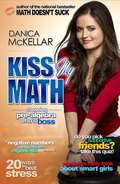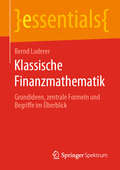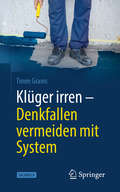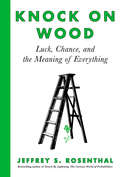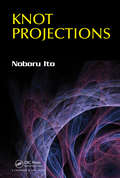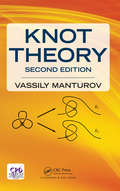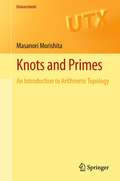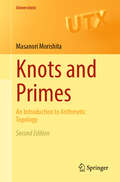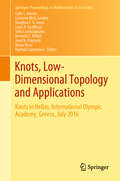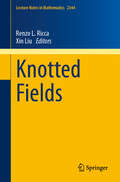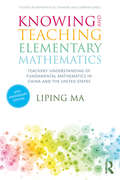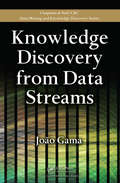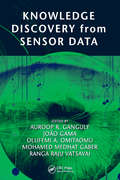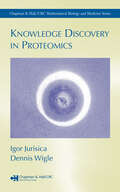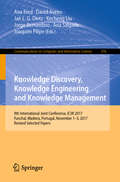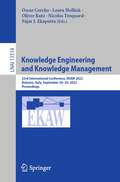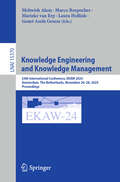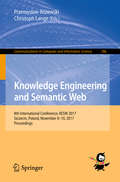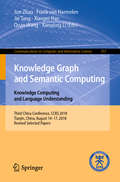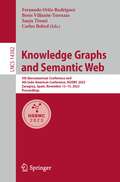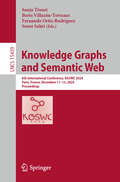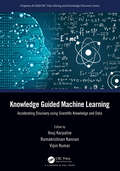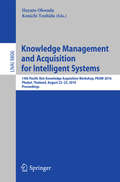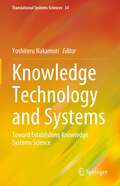- Table View
- List View
Kiss My Math: Showing Pre-Algebra Who's Boss
by Danica MckellarKiss My Math will help math-phobic teenagers everywhere chill out about math, and finally negative numbers, variables, absolute values, exponents, and more. Each chapter features: Step-by-step instruction, time-saving tips and tricks, illuminating practice problems with detailed solutions etc.
Klassische Finanzmathematik: Grundideen, zentrale Formeln und Begriffe im Überblick (essentials)
by Bernd LudererDieses essential vermittelt grundlegende Formeln, Methoden und Ideen der klassischen Finanzmathematik. Da die klassische Finanzmathematik mit elementaren mathematischen Hilfsmitteln auskommt, kann jede/r interessierte Leser/in mit durchschnittlichen mathematischen Schulkenntnissen diesem Text gut folgen. Das Kernstück bilden Zins- und Zinseszinsrechnung, Rentenrechnung, Tilgungsrechnung und Kursrechnung. Eine größere Zahl praktischer Beispiele veranschaulicht die mathematischen Fragestellungen.
Klüger irren - Denkfallen vermeiden mit System
by Timm GramsKurz entschlossen — danebengehauen.... Vorher nachdenken, nachmessen oder kalkulieren wäre wohl besser gewesen! Dieses Buch hilft Ihnen, Ihre Denkmechanismen zu erkunden und zu verbessern. Fehler und Zufall treiben den Fortschritt an. So entsteht das Neue. Wer es sehen will, braucht Wissen und die Fähigkeit, überraschende Beobachtungen richtig einzuordnen.Es ist jedoch kein Erfolgsrezept, die alten Fehler wieder und wieder zu machen. Lernen Sie aus Ihren Reinfällen und denjenigen der anderen.Weniges wird uns bewusst. Denkmechanismen wirken meist im Verborgenen, ungefragt und blitzschnell. Sie sind bewährt, manchmal aber auch verkehrt. Optische und kognitive Täuschungen, irreführende Statistiken, Paradoxien, Manipulationsversuche lauern überall. Viele Irrwege lassen sich durch den Einsatz von etwas Logik und Mathematik vermeiden.Lernen Sie, wie Sie Warnzeichen erkennen und richtig deuten können, wie weit das von Ihnen oft und meist unbewusst genutzte Indifferenzprinzip trägt, welche Rolle Analogien bei der Entstehung des Neuen spielen und wann Sie gefahrlos verallgemeinern dürfen.2., überarbeitete und erweiterte Auflage.
Knock on Wood: Luck, Chance, and the Meaning of Everything
by Jeffrey S. RosenthalFor readers of Nassim Nicholas Taleb and Daniel Levitin with a twist of Bill Bryson—a lighthearted, entertaining and fateful exploration of luck in everyday lifeFor centuries, people around the world have prayed for good luck and warded against bad. Every language features a good luck greeting. Sailors have long looked for an albatross on the horizon as a symbol of good fortune. Jade, clovers, rabbits’ feet, wishbones: these items have lined the pockets of those seeking good fortune. For some, it’s bad luck to walk under a ladder, to enter and leave a home through different doors or to say “Macbeth” in a theatre. But is there such a thing as luck, or does luck often just explain common sense? Don’t walk under a ladder because, well, that’s just dangerous. You won the lottery not because of any supernatural force but because a random number generator selected the same numbers that you picked out at the corner store. You run into a neighbour from your street on the other side of the world: Random chance or pure fate? (Or does it depend on how much you like your neighbour?)Jeffrey S. Rosenthal, author of the bestseller Struck by Lightning: The Curious World of Probabilities, was born on a Friday the thirteenth, a fact that he discovered long after he had become one of the world’s pre-eminent statisticians. Had he been living ignorantly and innocently under an unlucky cloud for all those years? Or is thirteen just another number? As a scientist and a man of reason, Rosenthal has long considered the value of luck, good and bad, seeking to measure chance and hope in formulas scratched out on chalkboards.In Knock on Wood, Rosenthal, with great humour and irreverence, divines the world of luck, fate and chance, putting his considerable scientific acumen to the test in deducing whether luck is real or the mere stuff of superstition.
Knot Projections
by Noboru ItoKnot Projections offers a comprehensive overview of the latest methods in the study of this branch of topology, based on current research inspired by Arnold’s theory of plane curves, Viro’s quantization of the Arnold invariant, and Vassiliev’s theory of knots, among others. The presentation exploits the intuitiveness of knot projections to introduce the material to an audience without a prior background in topology, making the book suitable as a useful alternative to standard textbooks on the subject. However, the main aim is to serve as an introduction to an active research subject, and includes many open questions.
Knot Theory: Second Edition
by Vassily Olegovich ManturovOver the last fifteen years, the face of knot theory has changed due to various new theories and invariants coming from physics, topology, combinatorics and alge-bra. It suffices to mention the great progress in knot homology theory (Khovanov homology and Ozsvath-Szabo Heegaard-Floer homology), the A-polynomial which give rise to strong invariants of knots and 3-manifolds, in particular, many new unknot detectors. New to this Edition is a discussion of Heegaard-Floer homology theory and A-polynomial of classical links, as well as updates throughout the text.<P><P> Knot Theory, Second Edition is notable not only for its expert presentation of knot theory’s state of the art but also for its accessibility. It is valuable as a profes-sional reference and will serve equally well as a text for a course on knot theory.
Knots and Primes
by Masanori MorishitaThis is a foundation for arithmetic topology - a new branch of mathematics which is focused upon the analogy between knot theory and number theory. Starting with an informative introduction to its origins, namely Gauss, this text provides a background on knots, three manifolds and number fields. Common aspects of both knot theory and number theory, for instance knots in three manifolds versus primes in a number field, are compared throughout the book. These comparisons begin at an elementary level, slowly building up to advanced theories in later chapters. Definitions are carefully formulated and proofs are largely self-contained. When necessary, background information is provided and theory is accompanied with a number of useful examples and illustrations, making this a useful text for both undergraduates and graduates in the field of knot theory, number theory and geometry.
Knots and Primes: An Introduction to Arithmetic Topology (Universitext)
by Masanori MorishitaThis book provides a foundation for arithmetic topology, a new branch of mathematics that investigates the analogies between the topology of knots, 3-manifolds, and the arithmetic of number fields. Arithmetic topology is now becoming a powerful guiding principle and driving force to obtain parallel results and new insights between 3-dimensional geometry and number theory.After an informative introduction to Gauss' work, in which arithmetic topology originated, the text reviews a background from both topology and number theory. The analogy between knots in 3-manifolds and primes in number rings, the founding principle of the subject, is based on the étale topological interpretation of primes and number rings. On the basis of this principle, the text explores systematically intimate analogies and parallel results of various concepts and theories between 3-dimensional topology and number theory. The presentation of these analogies begins at an elementary level, gradually building to advanced theories in later chapters. Many results presented here are new and original.References are clearly provided if necessary, and many examples and illustrations are included. Some useful problems are also given for future research. All these components make the book useful for graduate students and researchers in number theory, low dimensional topology, and geometry.This second edition is a corrected and enlarged version of the original one. Misprints and mistakes in the first edition are corrected, references are updated, and some expositions are improved. Because of the remarkable developments in arithmetic topology after the publication of the first edition, the present edition includes two new chapters. One is concerned with idelic class field theory for 3-manifolds and number fields. The other deals with topological and arithmetic Dijkgraaf–Witten theory, which supports a new bridge between arithmetic topology and mathematical physics.
Knots, Low-Dimensional Topology and Applications: Knots in Hellas, International Olympic Academy, Greece, July 2016 (Springer Proceedings in Mathematics & Statistics #284)
by Louis H. Kauffman Sofia Lambropoulou Colin C. Adams Cameron McA. Gordon Vaughan F. R. Jones Kenneth C. Millett Jozef H. Przytycki Renzo Ricca Radmila SazdanovicThis proceedings volume presents a diverse collection of high-quality, state-of-the-art research and survey articles written by top experts in low-dimensional topology and its applications. The focal topics include the wide range of historical and contemporary invariants of knots and links and related topics such as three- and four-dimensional manifolds, braids, virtual knot theory, quantum invariants, braids, skein modules and knot algebras, link homology, quandles and their homology; hyperbolic knots and geometric structures of three-dimensional manifolds; the mechanism of topological surgery in physical processes, knots in Nature in the sense of physical knots with applications to polymers, DNA enzyme mechanisms, and protein structure and function. The contents is based on contributions presented at the International Conference on Knots, Low-Dimensional Topology and Applications – Knots in Hellas 2016, which was held at the International Olympic Academy in Greece in July 2016. The goal of the international conference was to promote the exchange of methods and ideas across disciplines and generations, from graduate students to senior researchers, and to explore fundamental research problems in the broad fields of knot theory and low-dimensional topology. This book will benefit all researchers who wish to take their research in new directions, to learn about new tools and methods, and to discover relevant and recent literature for future study.
Knotted Fields (Lecture Notes in Mathematics #2344)
by Xin Liu Renzo L. RiccaThis book provides a remarkable collection of contributions written by some of the most accredited world experts in the modern area of Knotted Fields. Scope of the book is to provide an updated view of some of the key aspects of contemporary research, with the purpose to cover basic concepts and techniques commonly used in the context of Knotted Fields. The material is presented to help the interested reader to become familiar with the fundamentals, from fluid flows to electromagnetism, from knot theory to numerical visualization, while presenting the new ideas and results in an accessible way to beginners and young researchers. No advanced knowledge is required, and at the end of each chapter, key references are provided to offer further information on particular topics of interest. All those keen on modern applications of topological techniques to the study of knotted fields in mathematical physics will find here a valuable and unique source of information. The work will be of interest to many researchers in the field.
Knowing and Teaching Elementary Mathematics: Teachers' Understanding of Fundamental Mathematics in China and the United States (Studies in Mathematical Thinking and Learning Series)
by Liping MaThe 20th anniversary edition of this groundbreaking and bestselling volume offers powerful examples of the mathematics that can develop the thinking of elementary school children. Studies of teachers in the U.S. often document insufficient subject matter knowledge in mathematics. Yet, these studies give few examples of the knowledge teachers need to support teaching, particularly the kind of teaching demanded by reforms in mathematics education. Knowing and Teaching Elementary Mathematics describes the nature and development of the knowledge that elementary teachers need to become accomplished mathematics teachers, and suggests why such knowledge seems more common in China than in the United States, despite the fact that Chinese teachers have less formal education than their U.S. counterparts. Along with the original studies of U.S. and Chinese teachers’ mathematical understanding, this 20th anniversary edition includes a new preface and a 2013 journal article by Ma, "A Critique of the Structure of U.S. Elementary School Mathematics" that describe differences in U.S. and Chinese elementary mathematics. These are augmented by a new series editor’s introduction and two key journal articles that frame and contextualize this seminal work.
Knowledge Discovery from Data Streams (Chapman & Hall/CRC Data Mining and Knowledge Discovery Series)
by Joao GamaSince the beginning of the Internet age and the increased use of ubiquitous computing devices, the large volume and continuous flow of distributed data have imposed new constraints on the design of learning algorithms. Exploring how to extract knowledge structures from evolving and time-changing data, Knowledge Discovery from Data Streams presents
Knowledge Discovery from Sensor Data
by Mohamed Medhat Gaber Olufemi A. Omitaomu Ranga Raju Vatsavai Auroop R. Ganguly JoÎo GamaAs sensors become ubiquitous, a set of broad requirements is beginning to emerge across high-priority applications including disaster preparedness and management, adaptability to climate change, national or homeland security, and the management of critical infrastructures. This book presents innovative solutions in offline data mining and real-time
Knowledge Discovery in Proteomics
by Igor Jurisica Dennis WigleMulti-modal representations, the lack of complete and consistent domain theories, rapid evolution of domain knowledge, high dimensionality, and large amounts of missing information - these are challenges inherent in modern proteomics. As our understanding of protein structure and function becomes ever more complicated, we have reached a point where
Knowledge Discovery, Knowledge Engineering and Knowledge Management: 9th International Joint Conference, IC3K 2017, Funchal, Madeira, Portugal, November 1-3, 2017, Revised Selected Papers (Communications in Computer and Information Science #976)
by David Aveiro Joaquim Filipe Kecheng Liu Ana Fred Jorge Bernardino Jan L. Dietz Ana SalgadoThis book constitutes the thoroughly refereed proceedings of the 8th International Joint Conference on Knowledge Discovery, Knowledge Engineering and Knowledge Management, IC3K 2017, held in Funchal, Madeira, Portugal, in November 2017.The 19 full papers presented were carefully reviewed and selected from 157 submissions. The papers are organized in topical sections on knowledge discovery and information retrieval; knowledge engineering and ontology development; and knowledge management and information sharing.
Knowledge Engineering and Knowledge Management: 23rd International Conference, EKAW 2022, Bolzano, Italy, September 26–29, 2022, Proceedings (Lecture Notes in Computer Science #13514)
by Oscar Corcho Laura Hollink Oliver Kutz Nicolas Troquard Fajar J. EkaputraThis book constitutes the refereed proceedings of the 23rd International Conference on Knowledge Engineering and Knowledge Management, EKAW 2022, held in Bolzano, Italy, in September 2022. The 11 full papers presented together with 5 short papers were carefully reviewed and selected from 57 submissions The previous event in the series, EKAW 2020, introduced a special theme related to “Ethical and Trustworthy Knowledge Engineering.” This theme is still very relevant in 2022, and thus has remained one of the core topics of the conference.The conference concerned with all aspects about eliciting, acquiring, modeling and managing knowledge, and the construction of knowledge-intensive systems and services for the semantic web, knowledge management, e-business, natural language processing, intelligent information integration, and much more.
Knowledge Engineering and Knowledge Management: 24th International Conference, EKAW 2024, Amsterdam, The Netherlands, November 26–28, 2024, Proceedings (Lecture Notes in Computer Science #15370)
by Marieke Van Erp Laura Hollink Mehwish Alam Marco Rospocher Genet Asefa GeseseThis book constitutes the refereed proceedings of the 24th International Conference on Knowledge Engineering and Knowledge Management, EKAW 2024, held in Amsterdam, The Netherlands, during November 26–28, 2024. The 28 full papers presented together were carefully reviewed and selected from 115 submissions. They focus on all aspects of knowledge in constructing systems and services for the semantic web, knowledge management, knowledge discovery, information integration, natural language processing, intelligent systems, e-business, e-health, humanities, cultural heritage, and beyond.
Knowledge Engineering and Semantic Web: 8th International Conference, KESW 2017, Szczecin, Poland, November 8-10, 2017, Proceedings (Communications in Computer and Information Science #786)
by Przemysław Różewski and Christoph LangeThis book constitutes the refereed proceedings of the 8th International Conference on Knowledge Engineering and the Semantic Web, KESW 2017, held Szczecin, Poland, in November 2017. The 16 full papers presented were carefully reviewed and selected from 58 submissions. The papers are organized in topical sections on natural language processing; knowledge representation and reasoning; ontologies and controlled vocabularies; scalable data access and storage solutions; semantic Web and education; linked data; semantic technologies in manufacturing and business.
Knowledge Graph and Semantic Computing. Knowledge Computing and Language Understanding: Third China Conference, CCKS 2018, Tianjin, China, August 14–17, 2018, Revised Selected Papers (Communications in Computer and Information Science #957)
by Frank Van Harmelen Quan Wang Jun Zhao Jie Tang Xianpei Han Xianyong LiThis book constitutes the refereed proceedings of the Third China Conference on Knowledge Graph and Semantic Computing, CCKS 2018, held in Tianjin, China, in August 2018.The 27 revised full papers and 2 revised short papers presented were carefully reviewed and selected from 101 submissions. The papers cover wide research fields including the knowledge graph, information extraction, knowledge representation and reasoning, linked data.
Knowledge Graphs and Semantic Web: 5th Iberoamerican Conference and 4th Indo-American Conference, KGSWC 2023, Zaragoza, Spain, November 13–15, 2023, Proceedings (Lecture Notes in Computer Science #14382)
by Boris Villazón-Terrazas Sanju Tiwari Fernando Ortiz-Rodriguez Carlos BobedThis book constitutes the refereed proceedings of the 5th Iberoamerican Conference and 4th Indo-American Conference on Knowledge Graphs and Semantic Web, KGSWC 2023, held jointly in Zaragoza, Spain, during November 13–15, 2023.The 18 full and 2 short papers presented were carefully reviewed and selected from 50 submissions. They focus on the following topics: knowledge representation; natural language processing/text mining; and machine/deep learning research.
Knowledge Graphs and Semantic Web: 6th International Conference, KGSWC 2024, Paris, France, December 11–13, 2024, Proceedings (Lecture Notes in Computer Science #15459)
by Boris Villazón-Terrazas Sanju Tiwari Fernando Ortiz-Rodríguez Soror SahriThis book constitutes the refereed proceedings of the 6th International Conference on Knowledge Graphs and Semantic Web, KGSWC 2024, held in Paris, France, during December 11–13, 2024. The 22 full papers and 1 short paper presented were carefully reviewed and selected from 58 submissions. They focus on latest scientific results and technology innovations related to the Knowledge Graphs and the Semantic Web.
Knowledge Guided Machine Learning: Accelerating Discovery using Scientific Knowledge and Data (Chapman & Hall/CRC Data Mining and Knowledge Discovery Series)
by Vipin Kumar Anuj Karpatne Ramakrishnan KannanGiven their tremendous success in commercial applications, machine learning (ML) models are increasingly being considered as alternatives to science-based models in many disciplines. Yet, these "black-box" ML models have found limited success due to their inability to work well in the presence of limited training data and generalize to unseen scenarios. As a result, there is a growing interest in the scientific community on creating a new generation of methods that integrate scientific knowledge in ML frameworks. This emerging field, called scientific knowledge-guided ML (KGML), seeks a distinct departure from existing "data-only" or "scientific knowledge-only" methods to use knowledge and data at an equal footing. Indeed, KGML involves diverse scientific and ML communities, where researchers and practitioners from various backgrounds and application domains are continually adding richness to the problem formulations and research methods in this emerging field. Knowledge Guided Machine Learning: Accelerating Discovery using Scientific Knowledge and Data provides an introduction to this rapidly growing field by discussing some of the common themes of research in KGML using illustrative examples, case studies, and reviews from diverse application domains and research communities as book chapters by leading researchers. KEY FEATURES First-of-its-kind book in an emerging area of research that is gaining widespread attention in the scientific and data science fields Accessible to a broad audience in data science and scientific and engineering fields Provides a coherent organizational structure to the problem formulations and research methods in the emerging field of KGML using illustrative examples from diverse application domains Contains chapters by leading researchers, which illustrate the cutting-edge research trends, opportunities, and challenges in KGML research from multiple perspectives Enables cross-pollination of KGML problem formulations and research methods across disciplines Highlights critical gaps that require further investigation by the broader community of researchers and practitioners to realize the full potential of KGML
Knowledge Management and Acquisition for Intelligent Systems
by Hayato Ohwada Kenichi YoshidaThis book constitutes the proceedings of the 14th International Workshop on Knowledge Management and Acquisition for Intelligent Systems, PKAW 2016, held in Phuket, Thailand, in August 2016. The 16 full papers and 5 short papers included in this volume were carefully reviewed and selected from 61 initial submissions. They deal with knowledge acquisition and machine learning; knowledge acquisition and natural language processing; knowledge acquisition from network and big data; and knowledge acquisition and applications.
Knowledge Management in Organizations: 14th International Conference, KMO 2019, Zamora, Spain, July 15–18, 2019, Proceedings (Communications in Computer and Information Science #1027)
by Lorna Uden I-Hsien Ting Juan Manuel CorchadoThis book contains the refereed proceedings of the 14th International Conference on Knowledge Management in Organizations, KMO 2019, held in Zamora, Spain, in July 2019. The 46 papers accepted for KMO 2018 were selected from 109 submissions and are organized in topical sections on: knowledge management models and analysis; knowledge transfer and learning; knowledge and service innovation; knowledge creation; knowledge and organization; information systems and information science; data mining and intelligent science; social networks and social aspects of KM; big data and IoT; and new trends in IT.
Knowledge Technology and Systems: Toward Establishing Knowledge Systems Science (Translational Systems Sciences #34)
by Yoshiteru NakamoriThis book discusses technology and systems to create valuable ideas from data through the construction of knowledge. The primary concern is to make better decisions about economic and management issues in today’s information-flooded society. Human creative activity is in the realm of soft technology, with no physical entity to operate. Focusing on the ability of knowledge as judgment power, this definition results: “Knowledge technology is soft technology that underpins the human creative activities of converting data and information into knowledge, creating new ideas based on that knowledge and validating those ideas.” That definition includes a wide range of soft technologies developed in informatics, management studies, and systems science. The knowledge system creates ideas from data and knowledge through knowledge technologies. Based on the proposition that knowledge emerges by the interaction between explicit and tacit knowledge, another definition is possible: “The knowledge system is a system that promotes interaction between codified and personalized knowledge and creates ideas for solving a specific problem.” Codified knowledge includes data and information, while personalized knowledge is empirical knowledge or wisdom that is difficult to put into words. Building a knowledge system requires mathematical or intelligent knowledge technology and participatory knowledge technology to create or manage codified knowledge and personalized knowledge. For example, a company builds cross-sectional knowledge systems by gathering human resources from various departments, according to the purpose, as in new product development or sales promotion. Chapter 1 defines knowledge technology and the knowledge system and organizes the challenges in their development, while Chapters 2 through 9 introduce mathematical or intelligent knowledge technologies by researchers at the forefront of knowledge technology development.
